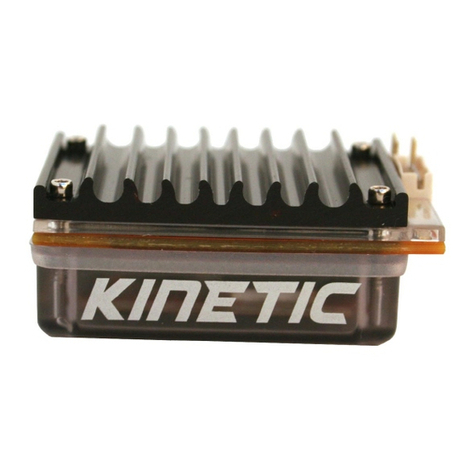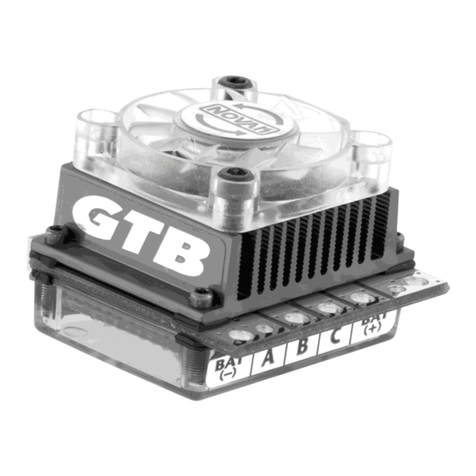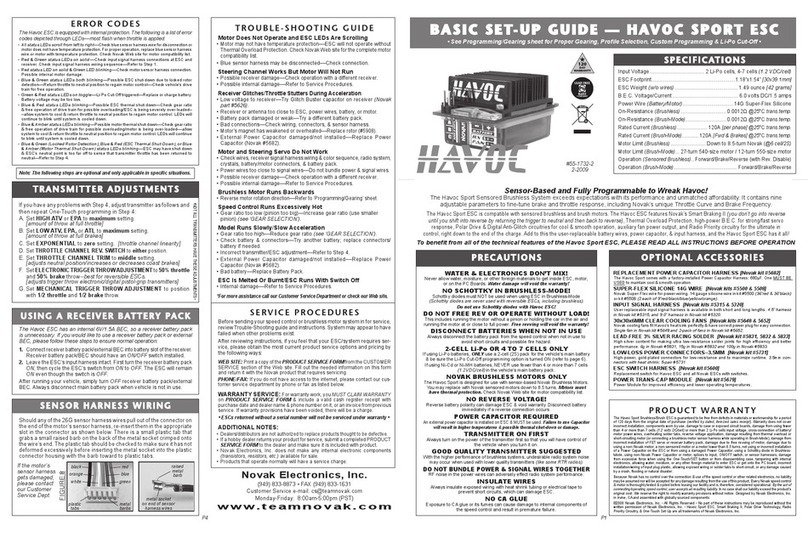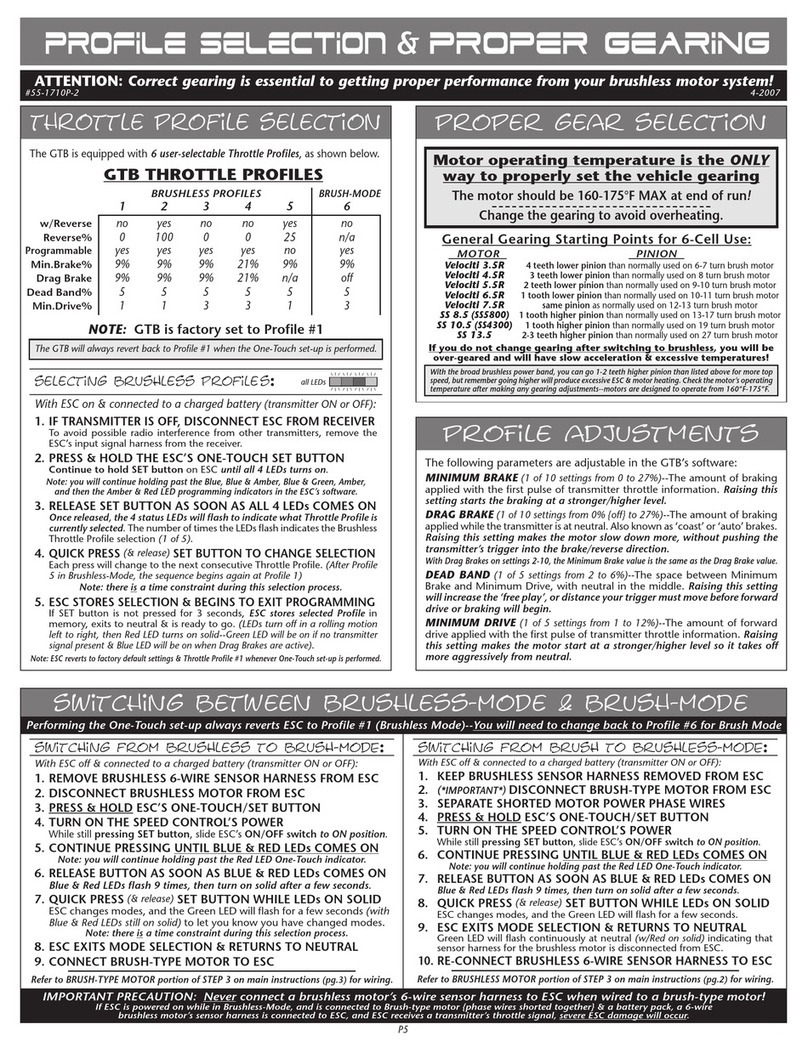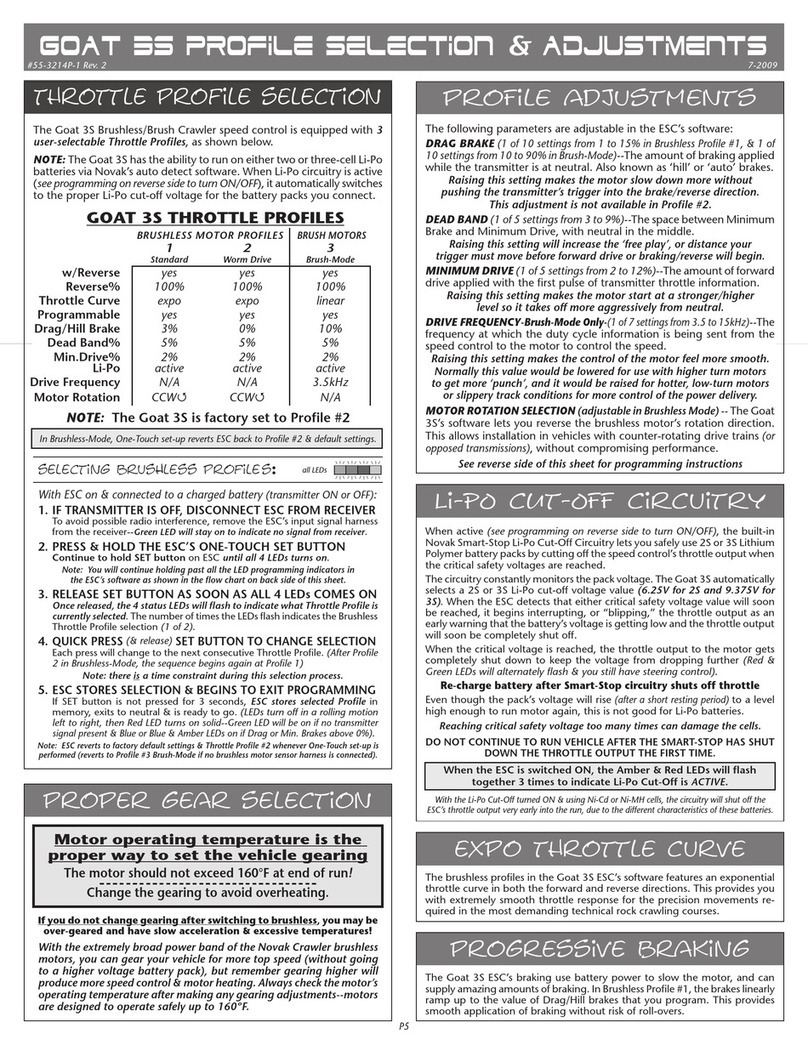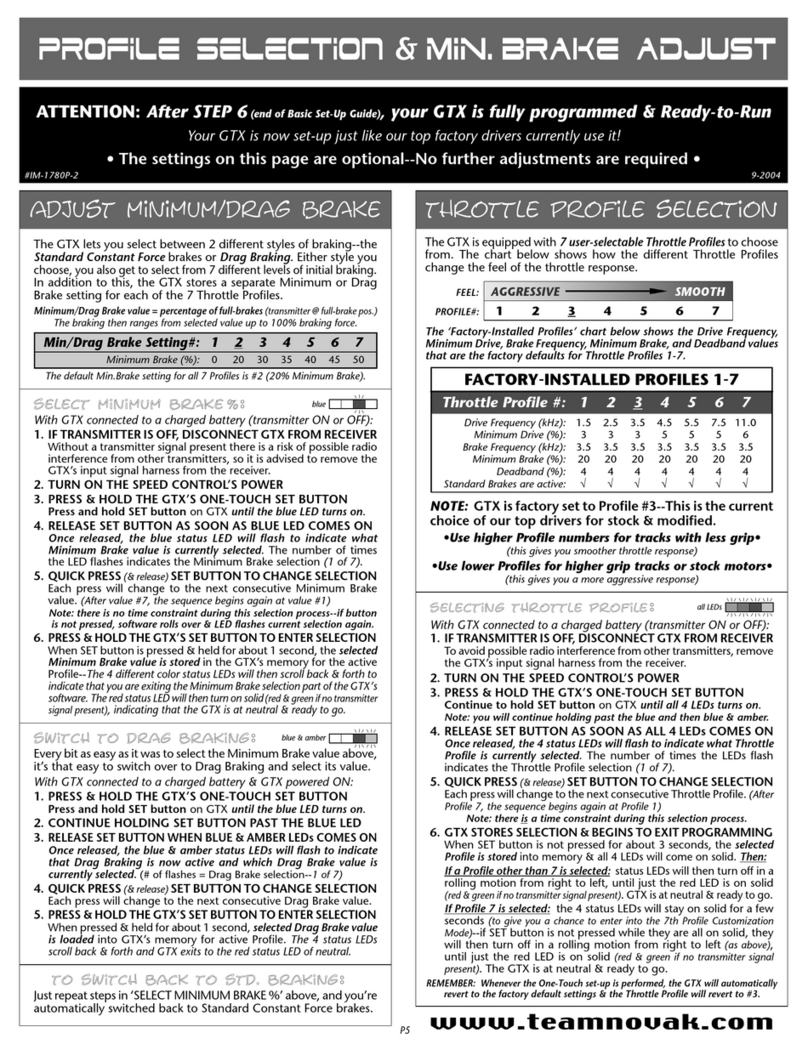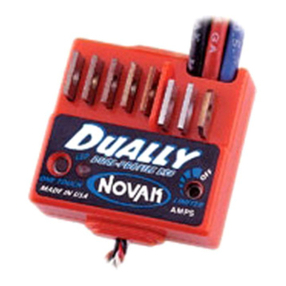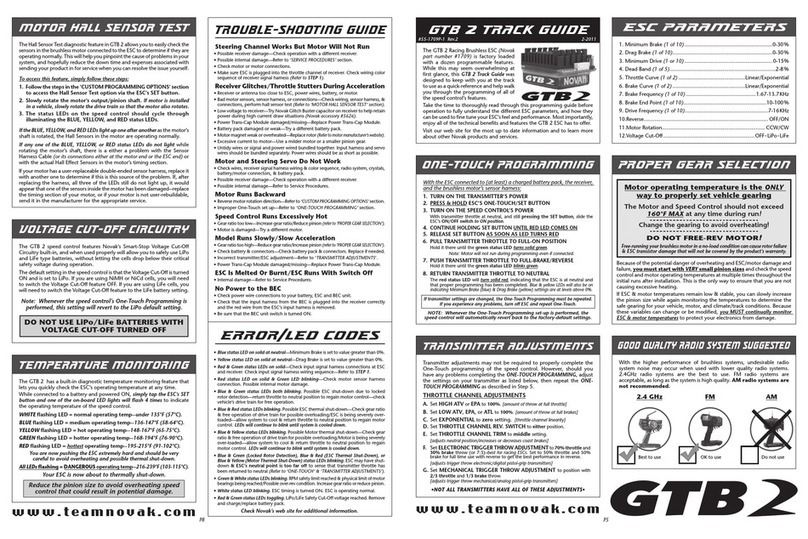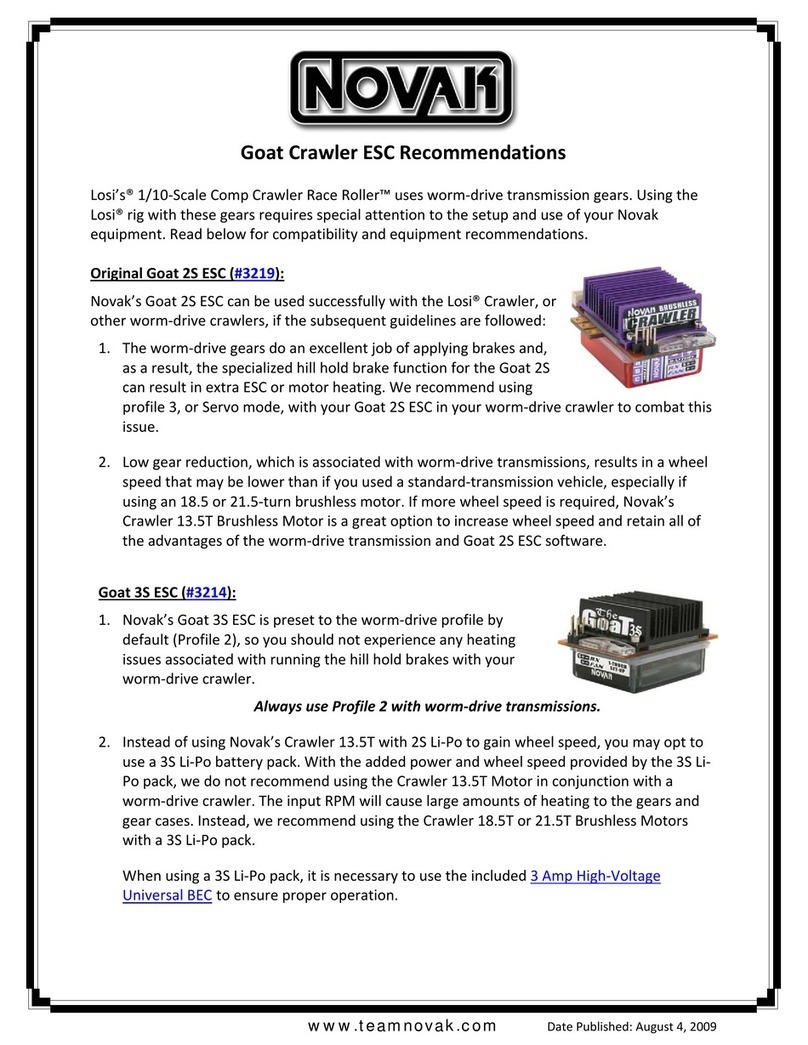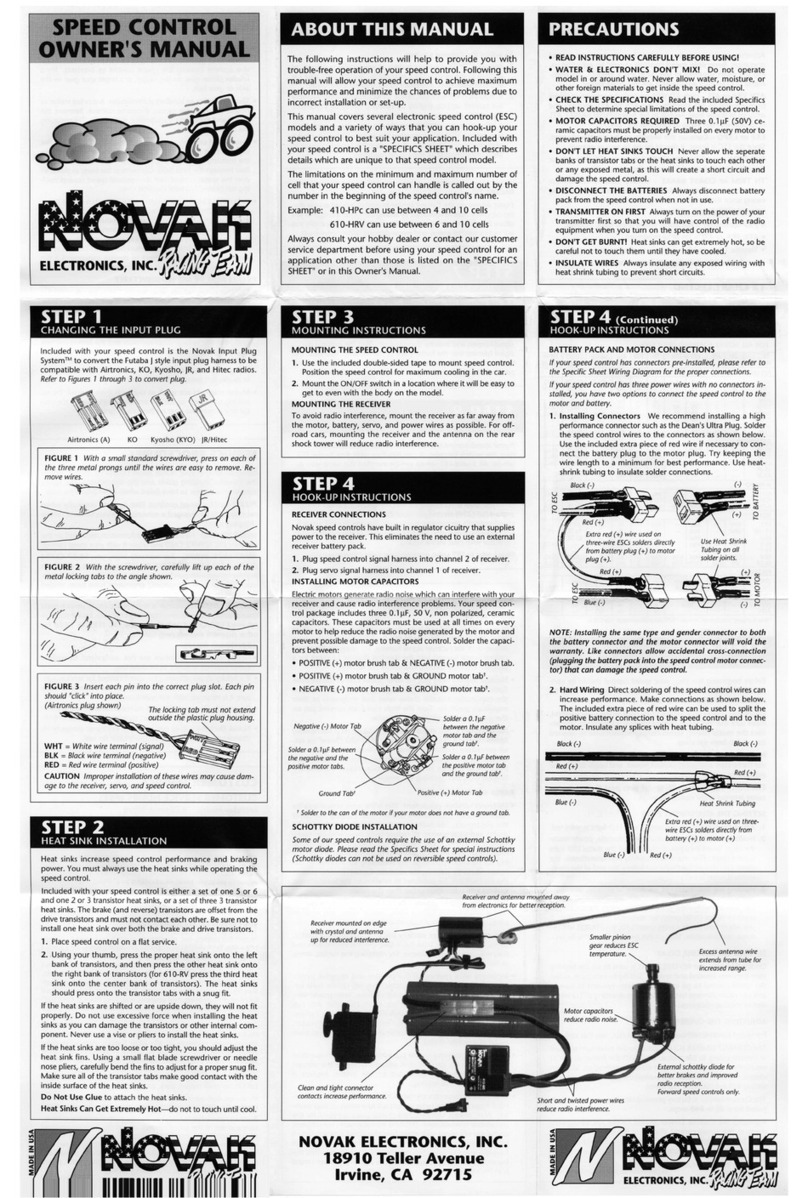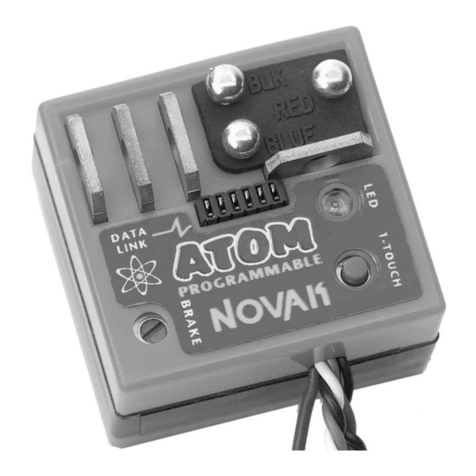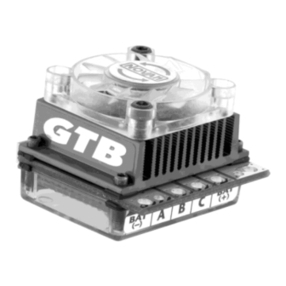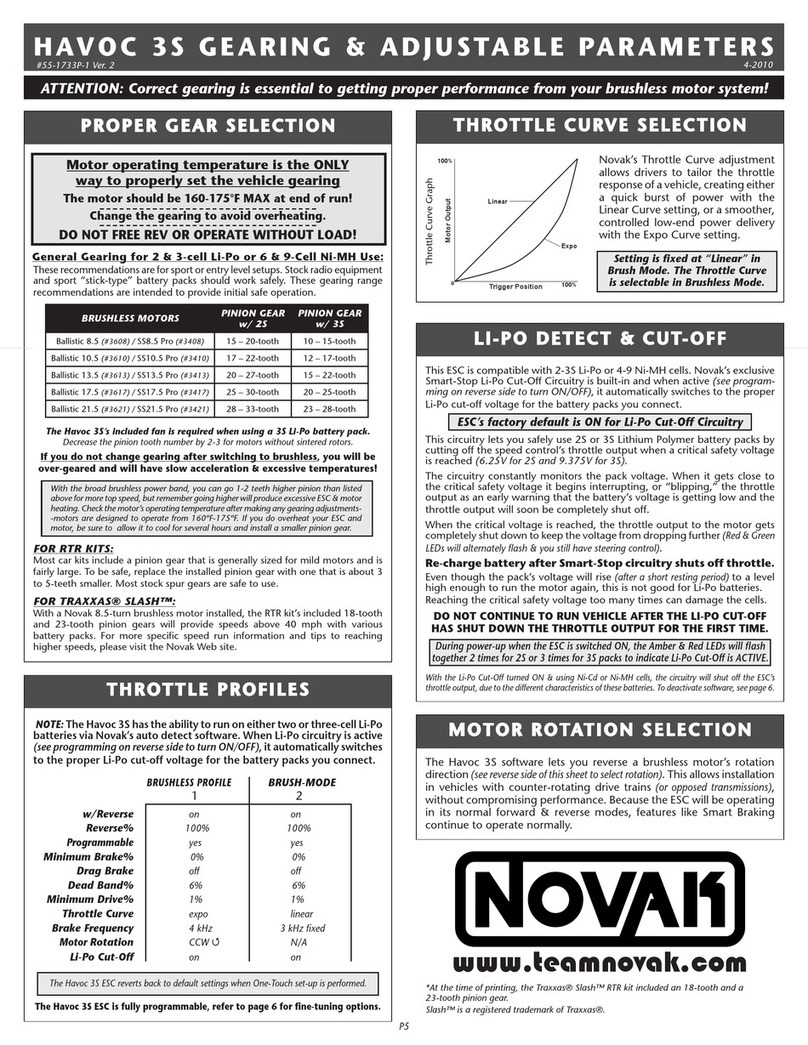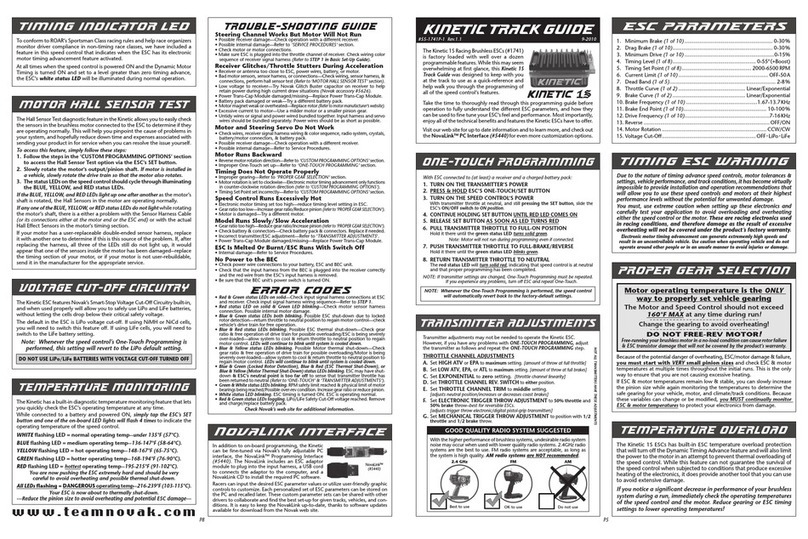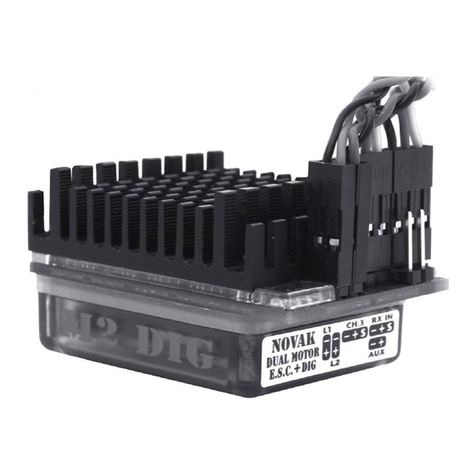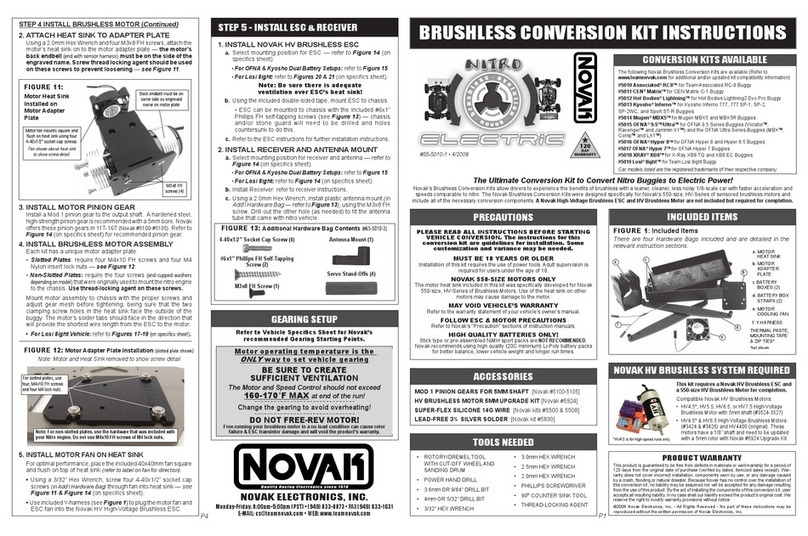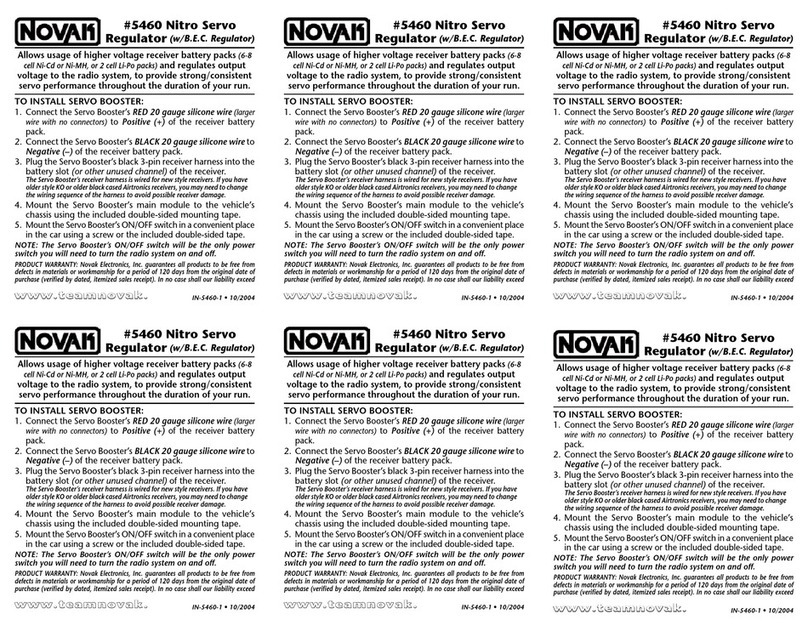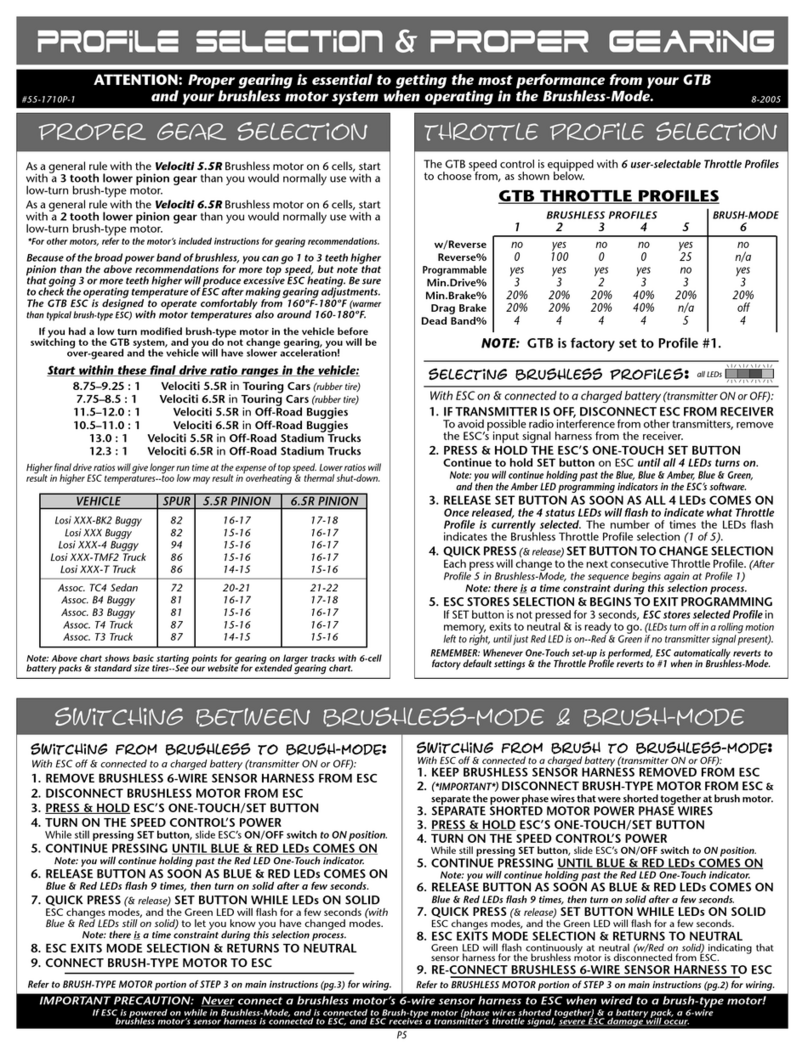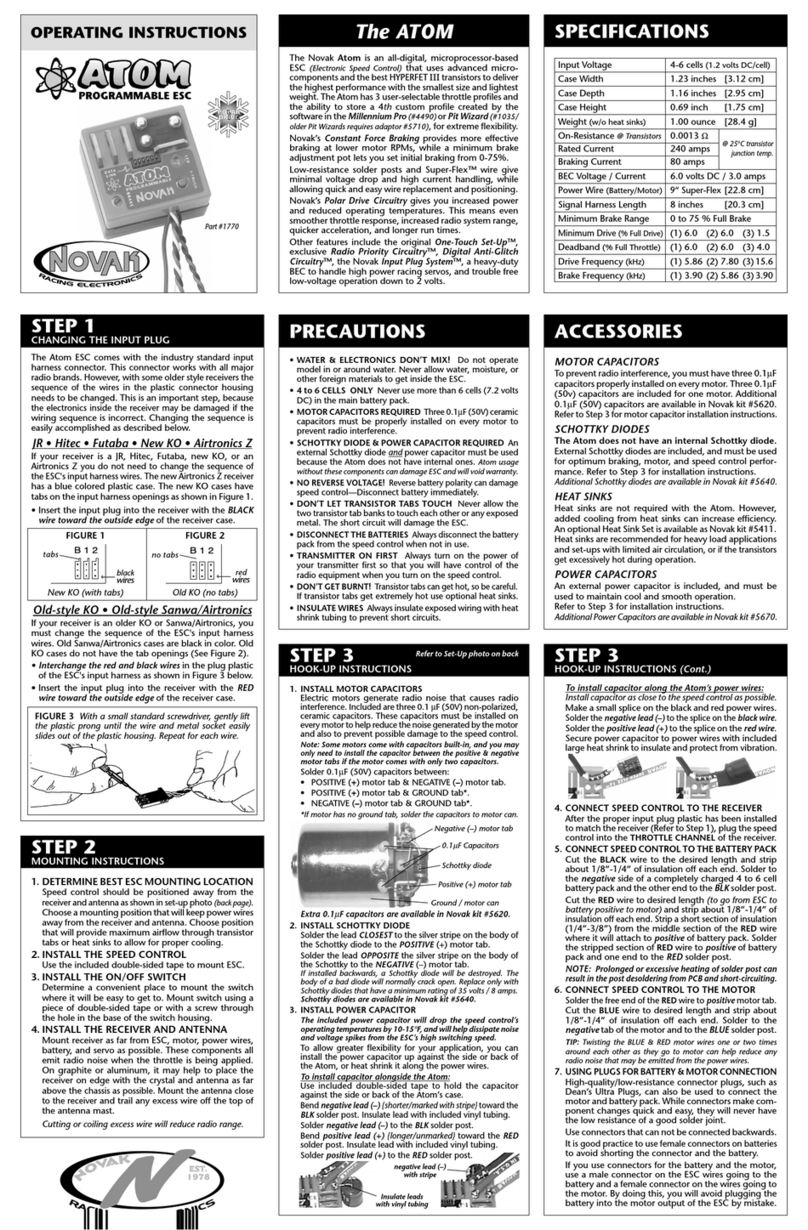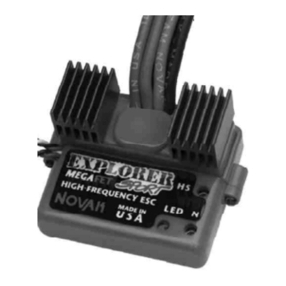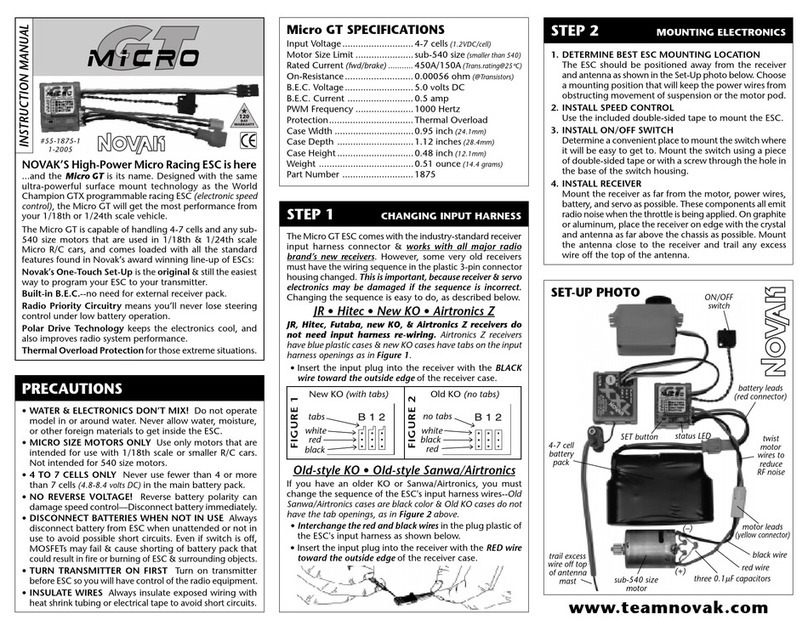STEP 3
HOOK-UP INSTRUCTIONS
Refer to set-up photo below
1. INSTALL MOTOR CAPACITORS
Electric motors generate radio noise that can interfere
with your receiver and cause radio problems. Included
in the accessory kit with the speed control are three
0.1µF (50V) non-polarized, ceramic capacitors. These
capacitors must be installed on every motor to help
reduce the noise generated by the motor and also to
prevent possible damage to the speed control.
Solder 0.1µF (50V) capacitors between:
• POSITIVE (+) motor tab & NEGATIVE (-) motor tab.
• POSITIVE (+) motor tab & GROUND tab*.
• NEGATIVE (-) motor tab & GROUND tab*.
*If your motor does not have a ground tab, solder the
capacitor leads to the can of the motor as shown below.
Negative (-) motor tab
0.1
µ
F Capacitors
Schottky diode
Positive (+) motor tab
Ground / motor can
2. CONNECT SPEED CONTROL TO THE RECEIVER
Plug the speed control into the THROTTLE CHANNEL
of the receiver.
3.
CONNECT SPEED CONTROL TO THE BATTERY PACK
Plug the white JST connector from the speed control
into the JST/Tamiya style connector on a fully charged
6 cell battery pack (1.2 volts DC/cell). The black wire is
negative (-) and the red wire is positive (+).
4. CONNECT SPEED CONTROL TO THE MOTOR
Plug the bullet connector on the red wire (+) of the
speed control to motor positive. Plug the other bullet
connector, on the blue wire (-), to motor negative.
Removing or changing the battery or motor connectors
may cause internal ESC damage and will void the warranty.
USE ONLY STOCK & MILD MODIFIED MOTORS (20 or
more turns only!)
with the Elektra speed control––Using
hotter motors and lower gear ratios will cause the speed
control to overheat.
TIP: Twisting the BLUE & RED motor wires one or two times around
each other as they go to motor can help reduce any radio noise
that may be emitted from the power wires. Refer to Set-Up photo.
5. OPTIONAL USE OF SCHOTTKY DIODE
The Elektra does not require an external Schottky diode.
However, using one will increase the efficiency and
reduce the operating temperature of the ESC.
Solder the lead
CLOSEST
to the silver stripe on the body
of the Schottky diode to the POSITIVE (+) motor tab.
Solder the lead OPPOSITE the silver stripe on the body
of the Schottky to the NEGATIVE (-) motor tab.
Schottky diodes are available in Novak kit #5640.
If installed backwards, a Schottky diode will be destroyed. The body
of a bad diode will normally crack open. Replace only with
Schottky
diodes that have a minimum rating of 35 volts / 8 amps.
Proper transmitter adjustment is important for optimum
performance from your speed control. The basic throttle
channel adjustments for the transmitter are as follows:
1. Set HIGH ATV or EPA to maximum setting.
[Controls amount of throw from neutral to full throttle]
2. Set LOW ATV, EPA, or ATL to maximum setting.
[Controls amount of throw from neutral to full brakes]
[Reduce this after ESC adjustment to reduce amount of brakes]
3. Set EXPONENTIAL to zero setting.
[Controls the linearity of the throttle channel]
4. Set THROTTLE CHANNEL TRIM to middle setting.
[Adjusts the neutral position of speed control]
[Increase or decrease after ESC adjustment to adjust coast
brakes––can be used to give braking in neutral trigger position]
5.
Set THROTTLE CHANNEL REVERSING SWITCH to
either position.
[Do not change switch position after programming]
6. Set ELECTRONIC TRIGGER THROW ADJUSTMENT to
70% throttle and 30% brake throw (or 7:3).
[Adjusts pistol-grip transmitter’s throttle trigger throw]
7. Set MECHANICAL TRIGGER THROW ADJUSTMENT
to position with 2/3 throttle and 1/3 brake throw.
[Adjusts pistol-grip transmitter’s throttle trigger throw]
STEP 4
TRANSMITTER ADJUSTMENT
STEP 5
SPEED CONTROL ADJUSTMENT
Before beginning this step, the ESC should be
connected
to the receiver and a charged 6 cell
battery pack, the
motor disconnected, and the transmitter adjusted.
Adjustment of your Elektra speed control is required for
proper operation. When the status LED is red, the speed
control is in the neutral position (no throttle or brake).
When the status LED is solid green, the ESC is at full
throttle, and it will be flashing green at full brake position.
1. CONNECT THE BATTERY
Plug the speed control into a fully charged 6 cell nickel-
cadmium or nickel-metal hydride Sub-C battery pack.
2. TURN ON THE TRANSMITTER
3. TURN ON THE SPEED CONTROL
Slide the ON/OFF switch to the ON position.
4. PRESS AND HOLD SPEED CONTROL’S SET BUTTON
With transmitter throttle at neutral, press and hold the
ESC SET button until the status LED turns solid red.
5. RELEASE ESC SET BUTTON WHEN LED IS RED
6.
PULL TRANSMITTER THROTTLE TO FULL-ON POSITION
Hold it there until the status LED turns solid green.
NOTE: The motor will not run during programming even if it
is connected to the speed control.
7. PUSH TRANSMITTER THROTTLE TO FULL-BRAKE
Hold it there until the status LED blinks green.
8. RETURN TRANSMITTER THROTTLE TO NEUTRAL
Status LED will turn solid red, indicating that throttle is
at neutral and proper programming has been completed.
9.
CHECK OPERATION OF THE SPEED CONTROL
Connect the motor and check for proper operation.
With no throttle or brake applied the status LED should
be solid red and the motor should not be running. At
full throttle the status LED should be solid green and
the motor running full speed. At full brakes the status
LED should be blinking green and the motor not running.
10.
SET THE COAST BRAKE AT TRANSMITTER (optional)
Adjust the
THROTTLE CHANNEL TRIM
on the transmit-
ter
to get more or less coast brake. This is accomplished
by slightly shifting the neutral position. After adjustment
be sure that the status LED is still green at full throttle.
Speed control is programmed & ready to run!
If your transmitter settings are changed at any time after
the speed control has been set-up, it will be necessary to
complete the programming sequence once again.
If you experience any problems during programming,
turn off the speed control and then repeat the entire
programming process again.
TROUBLE-SHOOTING GUIDE
This section describes possible speed control problems,
causes, and solutions.
Steering Channel Works But Motor Will Not Run
• Speed control has thermally shut down––Allow ESC to
cool down––Use milder motor or smaller pinion gear.
• Check motor connections. Check motor and brushes.
• Make sure ESC is plugged into the throttle channel of
receiver. Check throttle channel operation with a servo.
Check wiring color sequence of receiver signal harness.
• Possible internal damage––Refer to Service Procedures.
Receiver Glitches/Throttle Stutters During Acceleration
• Motor capacitors broken or missing––Refer to Step 3.
• Receiver or antenna too close to speed control, power
wires, battery, or motor––Refer to Step 2.
• Bad connections––Check wiring and connectors.
• Motor brushes worn––Replace brushes.
• Excessive current to motor––Use a milder motor or a
smaller pinion gear.
Motor and Steering Servo Do Not Work
• Check wires, receiver signal harness wiring and color
sequence, radio system, crystals, battery and motor
connectors, and battery pack.
• Possible internal damage––Refer to Service Procedures.
Model Runs Slowly / Slow Acceleration
•
Check motor and battery connectors––Replace if needed.
• Bad battery or motor––Check operation with another.
• Incorrect transmitter or speed control adjustment––Re-
fer to Steps 4 and 5.
• Optional external Schottky diode (if used) installed
backwards or damaged––Refer to Step 3.
Motor Runs Backwards
• Motor wired backwards––Check wiring and reverse.
• Backwards motor timing––Reverse motor end bell.
ESC Is Melted Or Burnt/ESC Runs With Switch Off
• Internal damage––Refer to Service Procedures.
•
Application of reverse voltage––Refer to Service Procedures.
*For more help call our Customer Service Department.
SERVICE PROCEDURES
Before sending in your Elektra for service, review the
Trouble-Shooting guide and the instructions. The ESC
may appear to have failed when other problems exist.
PLEASE NOTE: Speed controls that operate normally
when received will be charged a minimum service fee
and return shipping costs.
WHAT TO SEND: Fill out all of the information requested
on the enclosed ESC SERVICE CARD and return it with
your speed control.
WARRANTY WORK:
For warranty work, you MUST CLAIM
WARRANTY on the ESC SERVICE CARD and include a valid
cash register receipt with purchase date on it, or an in-
voice from previous service work. If warranty provisions
have been voided there will be a service charge.
SERVICE COSTS: Customer is responsible for all service
costs (parts, labor, and shipping/handling charges). See
ESC SERVICE CARD for payment and shipping options.
ADDITIONAL NOTES:
• Hobby dealers or distributors are not authorized to
re-
place speed controls thought to be defective.
• If a hobby dealer returns your speed control for service,
submit a completed ESC SERVICE CARD to the dealer
and make sure it is included with the speed control.
• Novak Electronics, Inc. does not make any electronic
components (transistors, resistors, etc.) available for sale.
• To provide the most efficient service possible to our cus-
tomers, it is not our policy to contact customers by
phone or mail.
PRODUCT WARRANTY
Novak Electronics, Inc. guarantees the Elektra to be free from
defects in materials and workmanship for a period of 120 days
from original date of purchase
(verified by dated, itemized sales re-
ceipt)
. Warranty does not cover incorrect installation, compo-
nents worn by use, damage from using fewer or more than 6
cells
(1.2 volts DC/cell)
input voltage, not using heat sinks, short-
circuiting heat sinks, cross-connection of battery/motor or
reverse voltage application, damage from incorrect installation
of FET servo or receiver battery pack, damage from
excessive
force
while installing heat sinks or pushing One-Touch button,
not
installing
three 0.1µF (50V) capacitors on motor, splices to
switch or receiver signal harnesses, removing or changing the
battery or motor connectors, damage from
disassembling case,
tampering with internal electronics,
allowing water, moisture, or
any other foreign material to enter
ESC or get onto PC board,
allowing exposed wiring to short-circuit, or any damage caused
by a crash.
In no case shall our liability exceed product's original cost. We
reserve the right to modify warranty provisions without notice.
Because Novak Electronics, Inc. has no control over connection
and use of the ESC, no liability may be assumed nor will be
accepted for damage resulting from the use of this product. Every
ESC is thoroughly tested and cycled before leaving our facility
and is, therefore, considered operational. By the act of
connect-
ing/operating ESC, the user accepts all resulting liability.
CUSTOMER SERVICE
CUSTOMER SERVICE HOURS (PST)
Monday-Thursday: 8:00am-5:00pm
Friday: 8:00am-4:00pm (closed every other Fri.)
(949) 833-8873 • FAX (949) 833-1631
©1999 Novak Electronics, Inc. • All Rights Reserved
No part of these operating instructions may be reproduced without the
written permission of Novak Electronics, Inc.
All Novak speed controls are designed and manufactured in the U.S.A.
Elektra™, Polar Drive Technology™, Radio Priority Circuitry™, One-
Touch Set-Up™, and Digital Anti-Glitch Circuitry™ are all trademarks of
Novak Electronics, Inc.
Printed in the U.S.A. 11/99 • #IM-1930-1
blue wire
(motor negative)
red wire
(motor positive)
Trail excess wire
off antenna mast.
(Do not cut or coil)
Tip: Twist motor wires
to reduce radio noise!
Keep receiver
and antenna
away from
motor, servo,
battery, and
power wires.
red wire
(battery positive)
black wire
(battery negative)
(-) (+)
Mount switch
where it will be
easy to get to.
(-)
(+)
ELEKTRA SET-UP
Extra 0.1
µ
F capacitors
available in Novak kit #5620.
NOVAK ELECTRONICS, INC.
18910 Teller Avenue
Irvine, CA 92612
www.teamnovak.com
motor with
20 or more
turns
6 cell
battery
pack
